English - MTU Onsite Energy
English - MTU Onsite Energy
English - MTU Onsite Energy
You also want an ePaper? Increase the reach of your titles
YUMPU automatically turns print PDFs into web optimized ePapers that Google loves.
<strong>MTU</strong> Brown <strong>MTU</strong> Brown<br />
0-17-28-62 80% der Farbe 60%<br />
CMYK CMYK CMYK<br />
<strong>MTU</strong> Blue <strong>MTU</strong> Blue<br />
60%<br />
50-25-0-10 80% der Farbe<br />
CMYK<br />
CMYK CMYK<br />
40%<br />
CMYK<br />
40%<br />
CMYK<br />
20%<br />
CMYK<br />
20%<br />
CMYK<br />
Mining<br />
For thousands of years man has looked to<br />
extract the planet’s minerals in one form or<br />
another. South Africa has always been at the<br />
forefront of this endeavour, starting with<br />
ancient civilisations looking to access the<br />
mystical powers of gold, to the famed gold<br />
rush in the 1880s. In fact, it would be safe<br />
to say that South Africa has led the world in<br />
the last 150 years with the city of Johannesburg<br />
or Egoli (Xhosa for City of Gold) –<br />
Africa’s economic powerhouse – having risen<br />
out of the original gold mines. All across the<br />
northern reaches of the country there are<br />
areas where mining is not only a way of life,<br />
but a life line.<br />
In one of the poorest provinces of South Africa,<br />
with 22% unemployment and other major socioeconomic<br />
issues, a job is what holds the key for<br />
most. With mining being the dominant industry<br />
and provider of jobs in the officially liquidated<br />
Limpopo Province, it is no wonder that families<br />
like Pompie Makgoba’s have been in the mining<br />
business for generations. It also makes it easier<br />
to understand why he and thousands of others<br />
wake up at 3:30 am every day to start work on<br />
the mines at 6 am. Pompie drives two hours just<br />
to get to work each day and roughly the same to<br />
get home to his wife and three children.<br />
Modikwa Platinum Mine<br />
Modikwa Platinum Mine has been in operation<br />
since 2003 and lies in a lush, subtropical igneous<br />
complex that spans hundreds of kilometres.<br />
Deceptive appearance:<br />
a green and sparsely<br />
populated landscape on<br />
the surface. But underground<br />
there are loud<br />
rumblings. The Modikwa<br />
platinum mine is located<br />
in an area in which<br />
extensive natural resources<br />
are hidden. Valuable<br />
metals are extracted<br />
from a total of 21 mines<br />
in the region.<br />
Entering the area of the mine, where a sprawl of<br />
villages and a snaking commercial zone hugs the<br />
main road from Burgersfort to Polokwane, is an<br />
array of mid-sized hilltops and rocky outcrops.<br />
Scores of car washes, fruit sellers, taverns and<br />
makeshift auto mechanics line up to ply their<br />
trade. There are 21 mines operating in the area,<br />
and a further 16 being developed. It is no surprise<br />
then that with this rich depository encased<br />
below the surface, the area experiences the highest<br />
density of lightning strikes in South Africa.<br />
Going underground – Safety a priority<br />
Pompie has worked at Modikwa Platinum Mine<br />
since 2006 and has worked on mines for 32<br />
years. He now finds himself in a good place and<br />
is happy to spend his days servicing the vehicles<br />
that do the hard work underground and on the<br />
surface. When asked about the ups and downs of<br />
the job, he quickly responds, “There is not much<br />
stress, because the engines are easy to service,<br />
but I don’t like going underground. It is too dangerous.”<br />
Modikwa boasts proud testimony to its<br />
emphasis on safety, with eight million fatality free<br />
shifts. This is a record in the South African<br />
Mining industry.<br />
On average, Pompie and his team of boiler<br />
mechanics will spend 20% of their time underground,<br />
servicing machines that are unable to<br />
come to the surface to be repaired at the workshop.<br />
For the other employees who are not so<br />
lucky, they will spend all of their time underground<br />
in shifts of up to 12 hours at a time.<br />
Modikwa is a decline mine, so there is no drop<br />
shaft and miners enter either by catching a lift in<br />
one of the vehicles descending the nine degree<br />
slope, or they take a chair lift reminiscent of those<br />
found in ski resorts, which comprises stool-like<br />
devices placed ten metres apart on a cable that<br />
loops to and from a central area below the surface.<br />
“Make big rocks into little rocks”<br />
There is a great deal happening at any one time<br />
on the mine. Five thousand employees in total<br />
and an arsenal of over 35 vehicles, performing a<br />
range of extremely attritional tasks, make it a very<br />
busy place. In a highly sophisticated engineering<br />
environment, with some of the most impressive<br />
power machinery available anywhere, the essence<br />
of the game remains simple – “make big rocks<br />
into little rocks”. Driving this overly simplistic<br />
description of the process on both North and<br />
South shafts at Modikwa is the <strong>MTU</strong> Series 904<br />
and <strong>MTU</strong> Series 926. Both vehicles are key to the<br />
reduction of bedrock to access the ore and eventually<br />
the refined precious platinum.<br />
Working at the face – well drilled<br />
Powering the drill rig, a vehicle used in the development<br />
of the stopes and tunnels underground,<br />
is the <strong>MTU</strong> Series 904. The drill rig is a futuristic<br />
construct which would look quite at home in the<br />
movie Transformers. With its six metre long boom<br />
reaching to the face, it pierces the solid earth,<br />
punching holes approximately 5cm wide; just<br />
enough to house and make way for the explosives.<br />
If the drill rig goes down, production slows.<br />
And in an operation that produces 240,000 tons<br />
of platinum per year and loses on average ten<br />
million rand for each day that production stops,<br />
reliability and peak performance are non-negotiables.<br />
It is one of the only machines on Modikwa<br />
that stays underground, even as blasting takes<br />
place. The three drill rigs on North and South<br />
shaft stay underground for a full week, being<br />
re-fuelled underground from containers delivered<br />
to it, when required.<br />
Botswana<br />
South Africa<br />
Zimbabwe<br />
MAP<br />
Mozambique<br />
Burgersfort<br />
Swaziland<br />
Indian<br />
Ocean<br />
28 I <strong>MTU</strong> Report 01/12


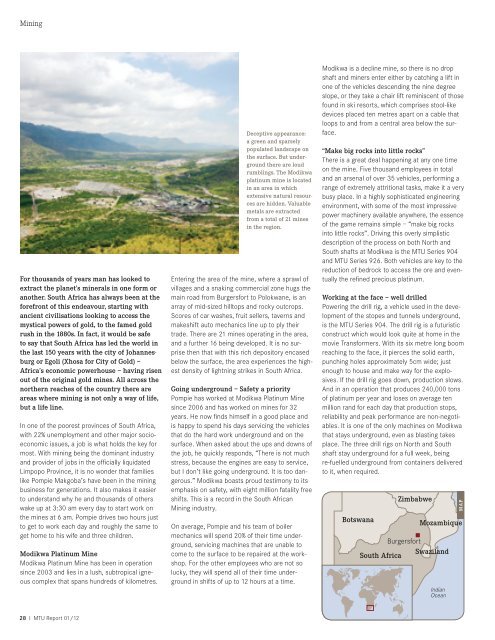
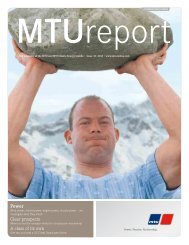

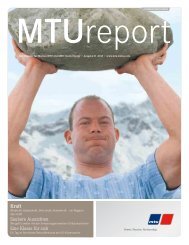
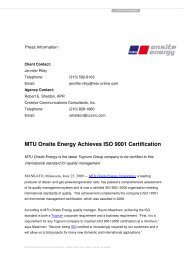

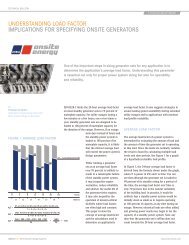
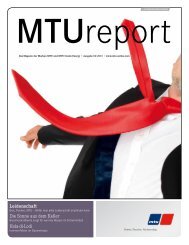

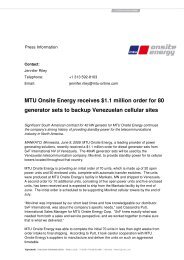
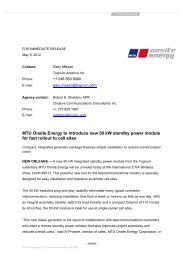


![Full power range of diesel generator sets [PDF] - MTU Onsite Energy](https://img.yumpu.com/28297693/1/190x253/full-power-range-of-diesel-generator-sets-pdf-mtu-onsite-energy.jpg?quality=85)
